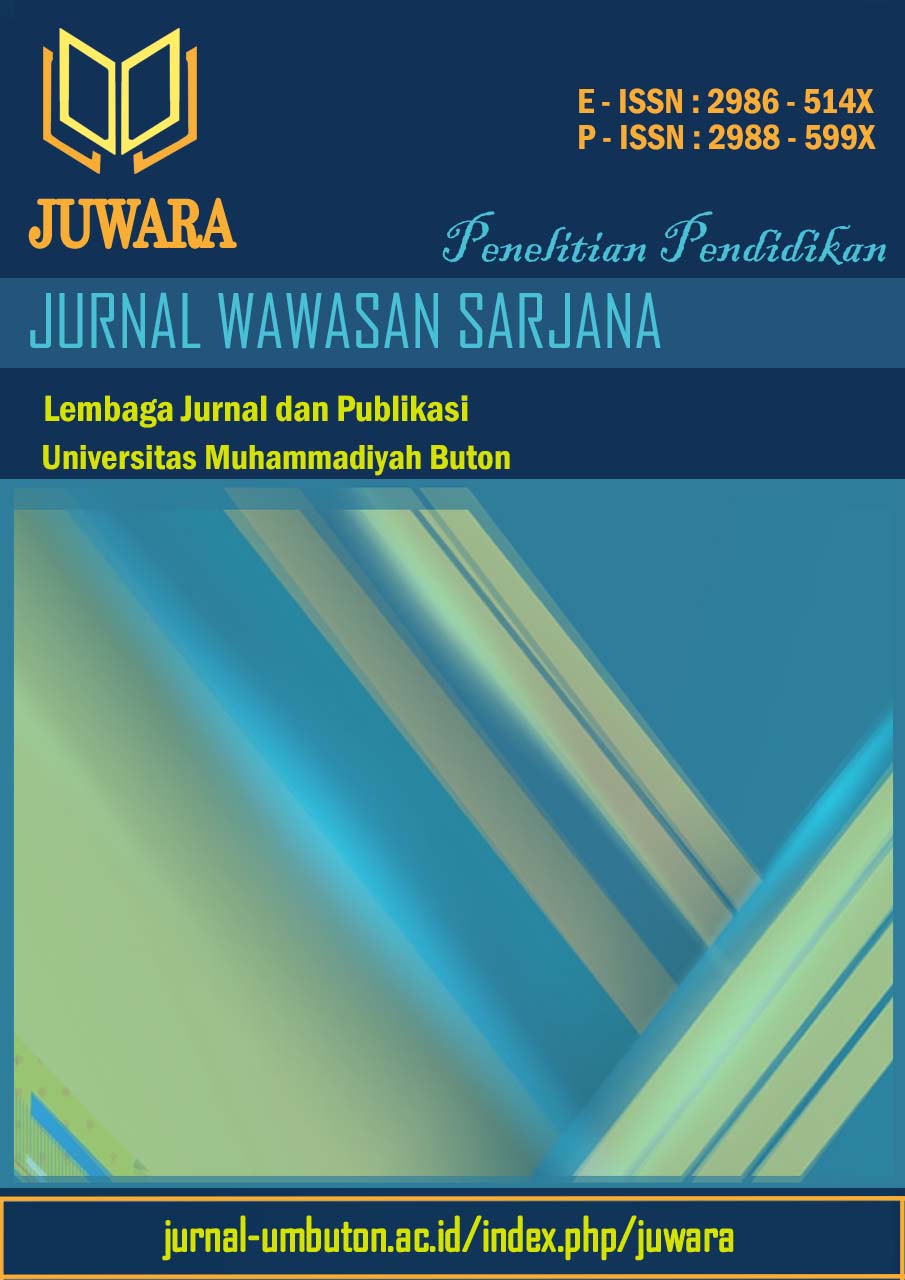Implementation of the Cooperative Learning Model Type TSTS Assisted by Concrete Media to Improve Mathematics Learning Outcomes
Keywords:
Cooperative Learning, Two Stay Two Stray, Concrete Media, Learning OutcomesAbstract
This study was conducted to improve the learning outcomes of second-grade students in mathematics at SD IT Rumah Anak Soleh Buton. The research applied classroom action research carried out in two cycles. Each cycle consisted of the stages of planning, implementation, observation, and reflection. The learning process was designed by applying the Cooperative Learning Model type Two Stay Two Stray, assisted by concrete media, to make mathematical concepts more accessible and meaningful for students. Data collection techniques included observation sheets, test instruments, and documentation, which were analyzed descriptively to capture both the process and the results of student learning. The findings of the study revealed that student learning outcomes improved across the cycles. Initially, many students had difficulty achieving the expected mastery in addition and subtraction, but after the implementation of the model, a significant improvement was observed. The cooperative approach encouraged active participation, peer learning, and better conceptual understanding. The use of concrete media also helped students relate abstract mathematical ideas to real-life contexts, thus strengthening their comprehension and motivation. Based on these results, it can be concluded that the Cooperative Learning Model type Two Stay Two Stray with concrete media is effective in improving mathematics learning outcomes among second-grade students.
Downloads
References
Ajaja, R., & Nwanekezi, A. U. (2018). Concept Mapping and Cooperative Learning Strategies on Junior Secondary School Students’ Performance in Social Studies. International Journal of Education and Evaluation, 4(9), 83-95.
Arends, R. (2018). Learning to teach. McGraw-Hill Education.
Danlami, K. B., Zakariya, Y. F., Balarabe, B., Alotaibi, S. B., & Alrosaa, T. M. (2025). Improving students' performance in geometry: an empirical evidence of the effectiveness of brainstorming learning strategy. Frontiers in Psychology, 16, 1577912.
Gillies, R. M. (2021). Promoting academic success and social competence in student learning through cooperative learning. Theory Into Practice, 60(1), 29–39. https://doi.org/10.1080/00405841.2020.1846206
Harahap, N. (2024). Implementation of the Two Stay Two Stray model in mathematics learning: Opportunities and challenges. Jurnal Pendidikan Dasar Nusantara, 10(2), 45–56.
Hasibuan, M. F. (2024). Efforts to Improve Student Learning Outcomes Through The Two Stay-Two Stray (TS-TS) Type Cooperative Learning Model In Class VI Mathematics Subjects At SDN 108384 Lubuk Pakam. Journal of Classroom Action Research, 3(1), 37-45.
Hernandez, M., & Brown, T. (2021). Cooperative learning and the use of visual media in improving mathematical comprehension. Journal of Educational Research and Practice, 11(3), 210–222.
Johnson, D. W., & Johnson, R. T. (2019). Cooperative learning: The foundation for active learning. Active Learning in Higher Education, 20(1), 4–18. https://doi.org/10.1177/1469787418824615
Killen, R. (2016). Effective teaching strategies: Lessons from research and practice. Cengage Learning.
Lee, J. (2021). Teachers as role models in developing students’ social and academic competencies. Journal of Education and Learning, 10(3), 45–54.
Lie, A. (2022). Cooperative learning in the Indonesian classroom. Indonesian Journal of Education, 6(2), 67–79.
Mawarni, S. (2023). The effectiveness of cooperative learning in improving mathematics achievement. Jurnal Pendidikan Matematika, 12(1), 23–35.
Nurlinda, E., Azis, Z., & Nasution, M. D. (2024). Students' Mathematical Reasoning Ability and Self-Efficacy Viewed from the Application of Problem Based Learning and Contextual Teaching and Learning Models Assisted. JMEA: Journal of Mathematics Education and Application, 3(2), 54-61.
Patel, R. (2022). Classroom management and cooperative learning: Building social interaction in schools. International Journal of Educational Psychology, 11(2), 89–102.
Piaget, J. (2019). The psychology of intelligence. Routledge.
Putra, A. (2022). The application of the Two Stay Two Stray model in elementary school mathematics learning. Jurnal Pendidikan Matematika Indonesia, 7(1), 55–63.
Sana, & Bachri, B. S. (2022). Faktor-faktor yang memengaruhi hasil belajar siswa sekolah dasar. Jurnal Ilmu Pendidikan, 8(2), 134–142.
Sepriyani, E. M., & Ahda, Y. (2023). The Effect of the Two Stay Two Stray Cooperative Learning Model (TSTS) Assisted by STEM-Based Interactive Media on Critical Thinking and Student Learning Outcomes on Sensory System Material. Jurnal Penelitian Pendidikan IPA, 9(12), 12073-12081.
Slavin, R. E. (2020). Cooperative learning: Theory, research, and practice (2nd ed.). Allyn & Bacon.
Slavin, R. E. (2020). Educational psychology: Theory and practice. Pearson Education.
Sunandar, D. (2023). Enhancing Mathematics Education Through Collaborative Learning: A Study of Two Stay Two Stray (Ts-Ts) and Think-Pair-Share (TPS) Models within Realistic Mathematics Education. International Journal of Enterprise Modelling, 17(3), 130-138.
Syabna, L., & Suriani, A. (2025). Transformation of teacher roles in character education. Jurnal Pendidikan Karakter, 13(1), 77–90.
Vygotsky, L. S. (1978). Mind in society: The development of higher psychological processes. Harvard University Press.
Webb, N. M. (2017). Peer interaction and learning in small groups. International Journal of Educational Research, 86, 16–26.
Widianita, R. (2023). Concrete media in cooperative learning for mathematics classrooms. Jurnal Penelitian Pendidikan Dasar, 11(2), 101–112.
Yusnan, M. (2025). Media Pembelajaran Interaktif (Konsep dan Analisis di Sekolah Dasar). CV. Eureka Media Aksara.
Yusri, N. S., & Sulaiman, N. A. (2024). Willingness to Communicate Among Pre-University ESL Learners: Teachers’ Perceptions and Teaching Strategies. International Journal of Academic Research in Business and Social Sciences, 14(8).
Yusuf, Q., Jusoh, Z., & Yusuf, Y. Q. (2019). Cooperative Learning Strategies to Enhance Writing Skills among Second Language Learners. International Journal of Instruction, 12(1), 1399-1412.
Zuo, S., Huang, Q., & Qi, C. (2024). The relationship between cognitive activation and mathematics achievement: mediating roles of self-efficacy and mathematics anxiety. Current Psychology, 43(39), 30794-30805.










